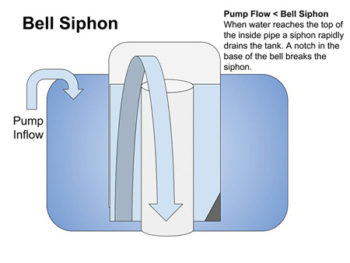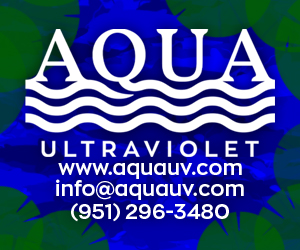
Aquaponics refers to a system that grows fish and plants together. Plants use fish waste as fertilizer, and in most instances, they filter the water to provide good water quality for the fish.
This system is fascinating to a variety of people and groups — professional gardeners, aquaculturists, aquarium keepers, water gardeners, organic gardeners, tinkerers, engineers and anybody simply interested in using a safe source of homegrown food for their family. It is a system of choice for educators, as it covers all aspects of STEM education and holds the attention of practically any student. As a water-garden professional, you are probably intrigued as well.
The Skinny on the Systems
There are two basic types of plant culture systems: media beds and deep water culture. Media beds are just that — beds of gravel or clay pebbles where seedlings are planted directly. Water floods and drains in cycles, allowing the roots to experience a dry cycle with plenty of access to oxygen. Deep water culture consists of floating rafts with a grid of planting sites in constructed tanks approximately 12 inches deep. Aerated water flows through the tanks, and the plant roots dangling under the rafts pick up nutrients directly from the water. Deep water culture cannot tolerate the buildup of solids and must have filtration components to remove them before water enters the plant side of the system.
A well-functioning aquaponics system with a 300-gallon fish tank, filter and two 4-by-8-foot deep water culture plant beds should be able to produce 150 to 200 pounds of fish and 1,500 to 2,000 heads of lettuce annually. The seed-to-harvest time for the lettuce is in the 45-day range. A system with only clarifiers for filtration should be able to support 1 square meter of plant production for every 60 grams of feed, or about 2 ounces of feed for every 11 square feet of plant production. This ratio can be as low as 15 grams per square meter if you add a professional solids and nitrifying filter.
The Water Gardening Connection
In a similar approach to water gardeners, the aquaponic gardener often begins with a DIY project with cut barrels or a modified aquarium. After the fascination overflows, an investment is made in a larger scale of production. This familiar approach allows a hobbyist to learn the principles and management of aquaponics without getting too confused with technology.

We filter the water with plants, and the fish provide the nutrients. After all, gravel-filled bogs have been around much longer than skimmers and biofalls for effective filtration. While the water gardener grows an ornamental plant with a low-nutrient water source, the aquaponic gardener grows an edible product and aims toward much more nutrient-rich water. While water quality for our koi and ornamental goldfish may be the focus of our efforts with plant-based filtration, the focus is primarily on vegetable production in aquaponics, with fish serving as a nutrient generator.
Aeration
Aeration is a necessity, not a luxury. It drives the production of your plants and fish and serves as the oxidizing energy that transforms the fish waste into usable nutrients, keeping them safe for plants and fish in the system. In past years, aquaponics has depended on the circulation pump to provide aeration. Keep in mind, this is not a waterfall pump — it’s a smaller pump operating a filter with a much slower rate of turnover. The latest technology partially or completely eliminates the pumps from the system, using airlifts to transfer the water, aerating it more thoroughly in the process. However, upsizing the air pump and providing air for deep water plant culture tanks can be a cost-effective upgrade from outfitting the system with airlifts.
Several new, clever adaptations have emerged to more efficiently use airlifts, with combinations of check valves and a low-head water pump. Bell siphons are a great piece of simple engineering that can rapidly drain media bed tanks after they fill to a maximum level, creating an automatic drain and fill cycle. It requires no electricity or pump, just good simple engineering.
Decoupling Systems
The addition of a good filter can easily allow the two systems to operate separately as a filtered recirculating fish system and a hydroponic plant system. This has several advantages, but some enthusiasts will initially see it as a loss of magic in the system. Even though I think the magic is still there and just as dynamic, it does increase the chance of success dramatically.
Removing the wastewater from the recirculating fish system and transferring it to a completely different water system for the plants allows for several improvements. If you need to treat your fish with salt, for example, it will not be acceptable for your plant system and could never be used in a coupled system. Likewise, if you need to treat your plants for a pest, the contaminated water should not return to the fish tanks.
Fish and hydroponic plants desire different pH levels. To date, aquaponics has not produced much in the way of fruiting vegetables, because nutrient concentration has been kept low to accommodate healthy conditions for fish. Split the system, and you can concentrate the waste from the fish tanks and adjust the pH for the ideal conditions for the plant roots, providing enough nutrients to produce fruiting vegetables.
Where does the water go? By transferring smaller amounts of concentrated filter water to the plant system, the entire volume of that water is completely consumed by evaporation and transpiration through the plant leaves. The only water that enters the system is added to the fish tank.
System Management
What about the solids in the media bed systems? Don’t they overwhelm them?

The answer is yes, unless you add red worms to the system to eat the sludge. They won’t drown as long as the system has enough oxygen in it. You commonly see this in streams and water gardens alike — earthworms active in the stream pockets or in a low biofilter, eating sludge. Aquaponics entrepreneurs have added these friends to media filters and discovered that not only do they consume sludge, but the castings left behind are also beneficial to plant production and do not degrade the water quality for the fish.
Quality aquaculture and koi feeds are made to be digestible and well balanced with respect to a variety of nutritional components, from protein to minerals. Specialized feeds have been designed to supply more than enough mineral components in the correct proportions to support quality fish growth. There will also be enough left over to supply to the aquaponic plant component of your system.
Configurations & Additions
Vertical towers are quite popular, despite some difficulties. Various designs include modified PVC with pockets and stackable, formed Styrofoam on a pole. Others produce plants in pockets as water trickles down from the top. Construction can be a hassle or expensive, with commercial units coming with a price tag of $8 per planting site. The latest in commercial towers provides a single tower with 100 planting sites, a practical installation and a dry-filled weight of 30 pounds, which costs about $3 per planting site.
Containment of the fish is relatively straightforward, with a few interesting adaptations. Drain and flow configurations are designed to remove solids. Since algae are not desired in any of the varieties of systems, keeping fish tanks covered or shielded from the sun is preferable. Sometimes the tanks have grates on top, acting as the floor in a greenhouse. This allows the space above for plant culture or other workspace.
If you plant to grow plants in a building without natural sunlight, or if you want to grow them in the winter, you will need artificial light. Before my latest research, I was quick to assume that LED fixtures were the last development in lighting. They do have a lot to offer, including lower heat, an adjustable spectrum and high intensity. What else could you want?
Well, I’ve recently discovered LEC, or light-emitting ceramic fixtures lighting. LECs are rapidly on the rise in hydroponics and are considered the latest technology in aquaponic plant production. They have a full spectrum of light, with increases in some segments of the lighting spectrum, which are beneficial for plant production.

But like any fast-growing industry with a technology component, there is a lot of enthusiasm, countless blog articles and some incredible claims floating around out there. Half-educated self-promoters abound. Always cross-reference your information and adjust it based on your own experience and knowledge. That being said, some new technology is on the rise, proving out genuine advancements in the field. Needless to say, separating the science from the hype is a challenge that the water-gardening industry has already navigated pretty well, in my opinion.
So at the very least, enjoy watching the aquaponics industry grow as an educated water-garden professional. You may find a new adaptation for a client or enjoy a new project at home. But, be careful. Just like water gardening, it can become an obsession.


